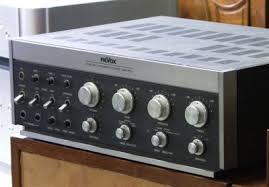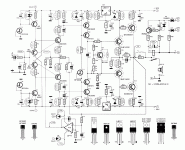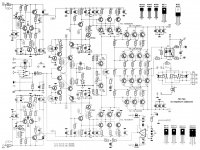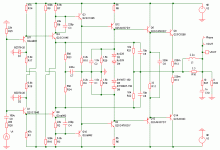No series cap, that tube amp shows 235kHz -3dB at 1W on transformer's output.
I meant no caps in feedback serial divider network (normally only two resistors in series from output to GND).
OK in this case you just have to calculate or measure maximum current value through that chatode resistor at max output amplitude. The same amount of current has to be provided from output via feedback resistor to get zero differential error current on that pin at that output swing. With choosen value of this feedback resistor and its voltage drop in ratio to voltage drop on chatode resistor, you will get voltage gain of such current feedback topology.
I had chosen low impedance 1k2/68r feedback resistors and used leds to provide the proper cathode bias voltage above the injection node which are very low AC impedance too and bypassed. Hmm, CFB then... that is why I get 0.017% THD and 235kHz -3dB at 1W from a transformer output tube amp, and ~100dB distance to noise floor.
Yes L.C. And i don't deserve your compliments:nothing will be ever the same, no way back syndrom
You are the author, i'm here just commenting *your work*.
The author of what i consider as the most interesting and best analog power amp structure i had seen since 40 years and more.
It can -has been and and will be, i'm sure- declined in a lot of versions, from simple to most sophisticated ones.
The design is there, and so the sound, it is just a matter of coloring inside ;-)
I think most of us would really like to see him contributing in this thread, all along with Nelson Pass, both involved since very long time and in a different matter with Current feedback power amps, and both members of this forum.Salas said:If Scott Wurcer is reading at a point by any chance would be the main man...
Adding their own experiences, feelings, talent and notoriety to the amazing ones of Lazy Cat. Contributing to make of one of the most beautiful analog power amp the best one ever in the audiophile minds.
I don't imply Lazy Cat need help from anybody, as he is always so accurate and full of taste. But i believe in collaborative work and shared ideas for the last coats of varnish.
An i think too that Lazy Cat really deserve some kind of Oscar from famous people of the profession.
Those rare people, like L.C., who are committed to the pursuit of beauty and perfection, with no other considerations, deserve respect, admiration and ... affection.
Yes L.C. And i don't deserve your compliments:
You are the author, i'm here just commenting *your work*.
The author of what i consider as the most interesting and best analog power amp structure i had seen since 40 years and more.
It can -has been and and will be, i'm sure- declined in a lot of versions, from simple to most sophisticated ones.
The design is there, and so the sound, it is just a matter of coloring inside ;-)
I think most of us would really like to see him contributing in this thread, all along with Nelson Pass, both involved since very long time and in a different matter with Current feedback power amps, and both members of this forum.
Adding their own experiences, feelings, talent and notoriety to the amazing ones of Lazy Cat. Contributing to make of one of the most beautiful analog power amp the best one ever in the audiophile minds.
I don't imply Lazy Cat need help from anybody, as he is always so accurate and full of taste. But i believe in collaborative work and shared ideas for the last coats of varnish.
An i think too that Lazy Cat really deserve some kind of Oscar from famous people of the profession.
Those rare people, like L.C., who are committed to the pursuit of beauty and perfection, with no other considerations, deserve respect, admiration and ... affection.
Where have you been for the last 40 years ??
This design structure dates from the early 1960s and there has been more than a dozen commercial offerings using it, not to mention the more than 3 dozen diy versions floating around the net.
Please, can-you provide links ?Where have you been for the last 40 years ??
This design structure dates from the early 1960s and there has been more than a dozen commercial offerings using it, not to mention the more than 3 dozen diy versions floating around the net.
The first solid state Current feedback power amp i've heard about was an Analog device study from Mark Alexander: http://www.analog.com/static/import...tes/58052492001115525484056221917334AN211.pdf that i tried at this time (AD was offering an evaluation board to his clients).
I knew only two solid state commercial power amps using current feedback (One from Mark Levinson), and only one or two DY .( One from jean Hiraga,).
None of them are using the SSA symmetrical CR implementation, and the only similar one i can refer too was the F5 from Nelson Pass:
http://www.firstwatt.com/pdf/prod_f5_man.pdf
I'm very curious to see what i've missed.
Last edited:
Please, can-you provide links ?
Elektor has used these extensively...
Attachments
Thanks, i missed those as as was most interested by power Fets. However, still not the symmetrical double current feedback paths, in there.Elektor has used these extensively...
[edit]...as says MiiB....;-)
Around 10k, depending of the Gain of the first stage transisto ?What is the default input impedance of the SSA and how can I increase it?
I don't thing increase-it is a good idea, as there is a cable at the input. Asymetrical links need some signal current to sound good and low impedance to minimize parasitic capacitances effects. Better boost (a lot) your preamp output OMHO.
Last, even with 10k, i cannot imagine a preamp unable to drive <2V rms under 10K.
Thanks, i missed those as as was most interested by power Fets. However, still not the symmetrical double current feedback paths, in there.
[edit]...as says MiiB....;-)
Well , for the double path , why not a late 70s Revox B750..??...
Attachments
Last edited:
Oh, man... You know what ? I had chosen Studer amps for my recording studio at those times (By habit they used to be the sames kind of stuff). For it sonic transparency and dynamic. Never looked at the schematic, as they where all working silent... And they where current feedback !!!!Well , for the double path , why not a late 70s Revox B750..??...
Thanks a lot for this -late- discovery...
Well , for the double path , why not a late 70s Revox B750..??...

Earlier Revox A740 (or Studer A68) has the same topology with double path.
/Martti
Hi guys 
Similarities with classical current feedback topology exist of course, I would be foolish not to admit that, but some guys here would like to sell me that SSA is the same. Mistake. I have to disappoint them in a major way. It is not. In the past I tested those classical current feedback schematics they posted above as a proof of copying. It was always disappointment listening to those creatures, I never liked them at all, never satisfied with the sound coming out of a speaker.
So I put the SSA in action.
SSA is unique idea because there's no existing amplifier's schematic the same, similar like the ones posted, but not the same. SSA is evolution from that point on. The major advantage of SSA principle is in merging, using a single gain device for feedback, modulation, differentiation and bias in a balanced bridge configuration. Everything is locked inside, it also has locked - unmatched sound signature (proved already by forum members, many ask themselves how come) because everything is happening in a circle of a single gain device for all the tasks needed to create an amplifier, simple and profound. Everything after this stage is just impedance matching till the output pins. Still important, like BIGBT output stage, but not crucial to get a perfect SSA sound.

Similarities with classical current feedback topology exist of course, I would be foolish not to admit that, but some guys here would like to sell me that SSA is the same. Mistake. I have to disappoint them in a major way. It is not. In the past I tested those classical current feedback schematics they posted above as a proof of copying. It was always disappointment listening to those creatures, I never liked them at all, never satisfied with the sound coming out of a speaker.

So I put the SSA in action.

SSA is unique idea because there's no existing amplifier's schematic the same, similar like the ones posted, but not the same. SSA is evolution from that point on. The major advantage of SSA principle is in merging, using a single gain device for feedback, modulation, differentiation and bias in a balanced bridge configuration. Everything is locked inside, it also has locked - unmatched sound signature (proved already by forum members, many ask themselves how come) because everything is happening in a circle of a single gain device for all the tasks needed to create an amplifier, simple and profound. Everything after this stage is just impedance matching till the output pins. Still important, like BIGBT output stage, but not crucial to get a perfect SSA sound.

Hi guys
Similarities with classical current feedback topology exist of course, I would be foolish not to admit that, but some guys here would like to sell me that SSA is the same. Mistake. I have to disappoint them in a major way. It is not. In the past I tested those classical current feedback schematics they posted above as a proof of copying. It was always disappointment listening to those creatures, I never liked them at all, never satisfied with the sound coming out of a speaker.
Please don't get me wrong. I'm not implying SSA is the same. I actually have a Revox A740 and it sounds quite ok (not disappointing but not spectacular either). Since I don't have golden ears I have not heard big differences between power amps anyhow. I may need to try SSA instead
/Martti
- Status
- This old topic is closed. If you want to reopen this topic, contact a moderator using the "Report Post" button.
- Home
- Amplifiers
- Solid State
- Simple Symetrical Amplifier


